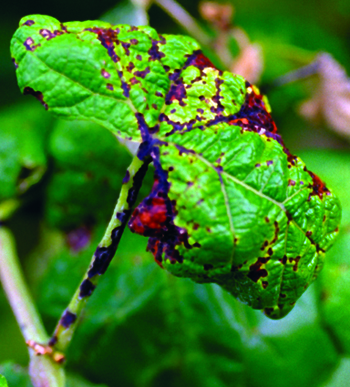Anthracnose: How to recognize and control this fungal disease of grapevines
Know what symptoms to look for when scouting for Anthracnose and implement a management plan in controlling this fungal disease.
Anthracnose is most common in southern grape-growing areas, but also sporadically occurs in Michigan. Lesions are now visible on leaves, shoot internodes, and clusters. Some table grape varieties are particularly susceptible, including Marquis and Mars. In addition, wine grapes varieties like Frontenac, Vidal and Marquette can be affected. The disease also sometimes occurs on Concord and Niagara vines. The disease is caused by a fungus called Elsinoe ampelina. Anthracnose reduces the quality and quantity of the fruit and weakens the vine.
Symptoms
On leaves, more or less circular, chocolate brown spots (1 to 5 mm in diameter) develop. The centers eventually become bleached and fall out, giving a “shot hole” appearance. Lesions along the veins may cause curling and distortion of the leaves as they expand. On shoots, spots are roughly oval, sunken and purplish-brown with gray centers and raised edges. Shoot tips may be killed and look burned. On older canes, lesions may extend into the pith and have thick raised edges and may be confused with hail injury. On berries, spots 2 to 7 mm in diameter are purplish-brown with a lighter center, giving them a “bird’s-eye” appearance. The lesions may eventually turn whitish gray surrounded by a narrow dark ring. Lesions may cause cracking of berries and render grapes unmarketable. Berries eventually shrivel up and mummify. Start monitoring for symptoms about two weeks from budburst.

Anthracnose lesions on grape leaf.
Biology of the pathogen
The fungus survives the winter in infected canes and berries in the vine and on the vineyard floor. In the spring, two types of spores (conidia and ascospores) are released that are spread by rain splash and by wind. Both can cause new infections on green plant parts. Spores produced in these primary lesions are spread by rainsplash. Young leaves and shoots are most susceptible to infection. Berries are susceptible from bloom until veraison (ripening), although the younger the fruit, the more susceptible it is. Anthracnose is especially severe during wet seasons. The optimum temperature for infection is 75 to 79ºF, although the fungus is active from 36 to 90ºF. Symptoms appear 4 to 13 days after infection.
Management
Purchase disease-free planting material from a reputable nursery. This is especially important when obtaining plants from areas where the disease is endemic. Choose resistant or less susceptible cultivars. Prune out diseased canes and fruit mummies. Remove infected plant material from the vineyard and destroy it. Dormant applications of lime sulfur or Bordeaux mixture are effective against the fungus, as are foliar applications of registered fungicides on two-week intervals during the growing season.
There is not much information available on fungicide efficacy, but the fungicides we have found most effective are Sovran, Abound, Endura, Pristine and Topsin M. Good activity is provided by Elite, Rubigan/Vintage, Penncozeb and Dithane.
For organic growers, sulfur and Serenade (+ spreader-sticker) are moderately effective options. Start sprays when shoots are 1 to 3 inches long to protect shoots and leaves and before bloom to protect fruit.
Dr. Schilder's work is funded in part by MSU's AgBioresearch.



 Print
Print Email
Email




